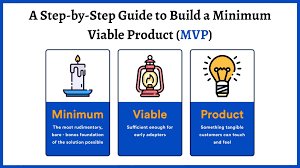In the fast-paced world of startups, creating a successful product means balancing innovation with speed and cost efficiency. One proven strategy for achieving this balance is developing a Minimum Viable Product (MVP). Learning how to build an MVP can help startups validate their ideas, attract early adopters, and reduce risks before committing significant resources.
This guide explores the technical aspects of startup MVP development, the MVP development process, identifying core MVP features, and the importance of MVP in product management.
What is an MVP?
An MVP, or Minimum Viable Product, is the most basic version of a product that solves a specific problem for early users. It includes only the essential features needed to test the idea, collect user feedback, and validate assumptions.
The goal is not to launch a perfect product but to learn quickly whether the product is viable and worth scaling.
Why Build an MVP?
- Validate Ideas Quickly: Testing your assumptions before investing heavily.
- Minimize Costs: Avoid unnecessary development expenses.
- Faster Time-to-Market: Deliver the core solution to users early.
- Collect User Feedback: Understand real-world behavior and needs.
- Attract Investors: Demonstrate traction and market interest.
How to Build an MVP
Learning how to build an MVP involves a series of technical and strategic steps. Let’s break it down.
Step 1: Identify the Problem
Every product starts with a problem statement. Clearly define:
- Who your target users are.
- What pain point they face.
- Why existing solutions are insufficient.
This clarity ensures your MVP directly addresses a real need.
Step 2: Conduct Market Research
Before starting startup MVP development, analyze:
- Competitors’ products.
- Market demand and trends.
- Gaps and opportunities.
Use surveys, interviews, and data analytics to confirm your assumptions.
Step 3: Define the Core Value Proposition
Your MVP should focus on one primary benefit. Ask:
- What is the single most important problem my product solves?
- What unique value will users gain?
This core value becomes the foundation for all MVP features.
Step 4: Prioritize MVP Features
Not every idea belongs in your first release. Categorize potential features into:
- Must-Have: Essential to solving the problem.
- Nice-to-Have: Enhancements for later stages.
- Future Additions: Advanced features once the product scales.
This prioritization keeps the MVP lean and effective.
Step 5: Design the User Flow
The MVP should offer a smooth, intuitive user journey. Map:
- Entry points (sign-up, login).
- Core task completion steps.
- Exit points (confirmation, feedback).
Wireframes and prototypes can help visualize the process before coding.
Step 6: Choose the Right Tech Stack
Technology decisions impact scalability, performance, and cost. Consider:
- Front-End: React, Angular, or Vue for responsive interfaces.
- Back-End: Node.js, Django, or Ruby on Rails for scalability.
- Database: PostgreSQL, MongoDB, or MySQL depending on needs.
- Hosting: Cloud platforms like AWS or Azure.
Choose tools that allow rapid iteration and support long-term scalability.
Step 7: Develop the MVP
Follow agile development practices:
- Break tasks into sprints.
- Build and test small increments.
- Keep code modular for easier updates.
The development should strictly focus on MVP features, avoiding feature creep.
Step 8: Test the MVP
Quality assurance is critical. Testing should cover:
- Functional Testing: Ensure features work as intended.
- Usability Testing: Verify ease of use.
- Performance Testing: Check scalability under load.
- Security Testing: Protect user data.
User acceptance testing (UAT) ensures that early adopters validate usability.
Step 9: Launch to Early Adopters
Roll out the MVP to a small, targeted group. Early adopters provide valuable insights that guide future development.
Step 10: Collect Feedback and Iterate
Use analytics and direct feedback to evaluate:
- Which features users engage with most.
- Where they drop off in the user journey.
- What improvements are requested.
This iterative cycle is the essence of the MVP development process.
The MVP Development Process in Detail
The MVP development process can be broken into three main phases:
- Discovery Phase
- Problem identification.
- Market research.
- Defining value proposition.
- Problem identification.
- Development Phase
- Designing wireframes and prototypes.
- Building the MVP.
- Testing for usability and functionality.
- Designing wireframes and prototypes.
- Feedback and Iteration Phase
- Launching to early adopters.
- Collecting analytics and feedback.
- Iterating with improved versions.
- Launching to early adopters.
This cycle repeats until the product achieves product-market fit.
MVP Features: What to Include
When deciding on MVP features, focus on:
- Core Functionality: Solve the main problem without extras.
- User Onboarding: Easy registration and guidance.
- Feedback Mechanism: Allow users to share experiences.
- Scalable Architecture: Codebase should handle growth.
- Analytics Tools: Track engagement, retention, and churn.
Remember: MVPs are not prototypes. While prototypes are for internal testing, MVPs are working products for real users.
MVP in Product Management
In product management, the MVP serves as a foundation for decision-making. Here’s how MVP in product management plays a crucial role:
- Validates Assumptions: Product managers can confirm whether the market wants the product.
- Guides Roadmaps: Insights from MVP use help prioritize future features.
- Mitigates Risks: Prevents large-scale investment in untested ideas.
- Aligns Teams: Keeps developers, designers, and stakeholders focused on solving the core problem.
- Facilitates Investor Interest: Early traction from MVPs helps attract funding.
By integrating MVP into product management, organizations adopt a lean, data-driven approach to product development.
Common Mistakes in MVP Development
- Building Too Many Features: Leads to wasted time and resources.
- Ignoring User Feedback: Fails to address actual user needs.
- Choosing the Wrong Tech Stack: Limits scalability.
- Unclear Value Proposition: Confuses users and reduces adoption.
- Poor Testing: Results in buggy, unreliable MVPs.
Avoiding these pitfalls ensures a smoother development journey.
Tools for MVP Development
Technical tools accelerate the MVP development process:
- Wireframing Tools: Figma, Balsamiq.
- Project Management: Jira, Trello.
- Prototyping: InVision, Adobe XD.
- Analytics: Google Analytics, Mixpanel.
- CI/CD Tools: Jenkins, GitHub Actions for faster deployment.
These tools help streamline communication, design, and iteration.
Real-World Applications of MVP
- Social Media Platforms: Started with core features like posting and messaging.
- E-commerce Sites: Began with simple product listings and checkout.
- SaaS Tools: Focused on solving one business pain point effectively.
These examples show that MVPs don’t need to be complex—they just need to prove the concept.
Scaling Beyond the MVP
Once an MVP proves successful:
- Expand features based on validated feedback.
- Improve UI/UX for better user retention.
- Optimize backend for higher loads.
- Integrate advanced analytics for smarter decisions.
The transition from MVP to full product should always be data-driven.
Conclusion
Learning how to build an MVP is one of the most valuable skills in today’s startup ecosystem. By following a structured MVP development process, focusing on essential MVP features, and leveraging the role of MVP in product management, startups can validate ideas quickly, reduce risk, and scale effectively.
Successful startup MVP development isn’t about perfection—it’s about progress, learning, and adaptation. With the right approach, an MVP becomes the launchpad for a scalable, successful product.For businesses seeking expert guidance and technical excellence in MVP design and development, many turn to Findthecoder, a trusted partner in building products that transform ideas into reality.

